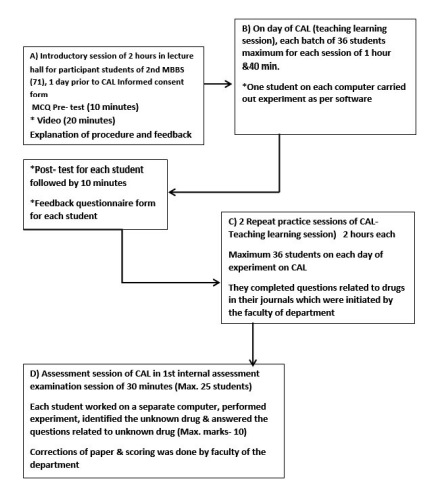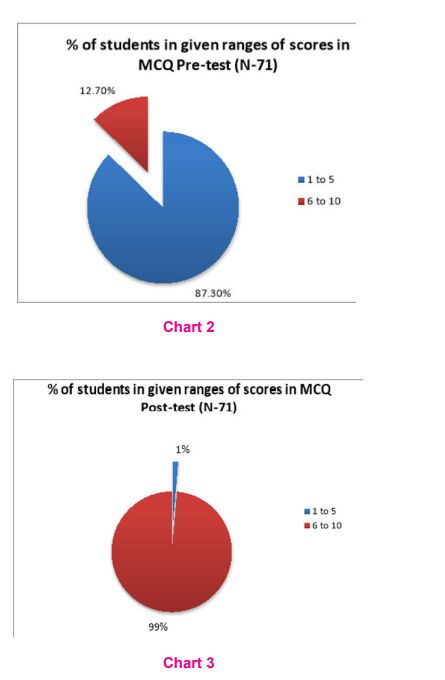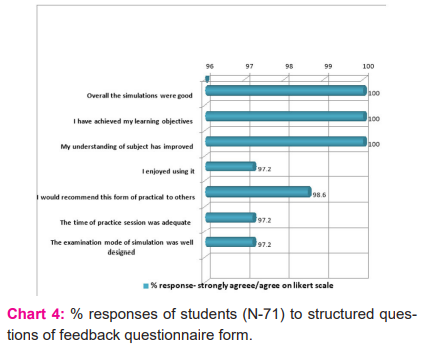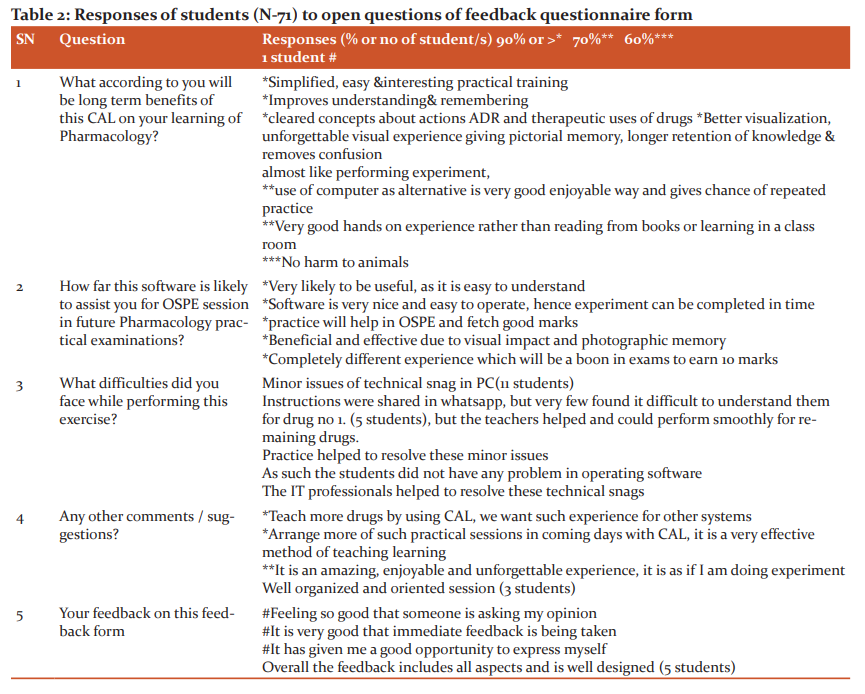IJCRR - 14(2), January, 2022
Pages: 47-53
Date of Publication: 16-Jan-2022
Print Article
Download XML Download PDF
\"Computer-Assisted Learning (CAL), a Teaching-Learning and Assessment Tool for CBME Curriculum in Practical Pharmacology for 2nd MBBS Students\"
Author: Meena Shrivastava, Anjali Ravindra Shinde, Suraj Patil
Category: Healthcare
Abstract:Introduction: The use of Computer-Assisted Learning is an important step to implement recommendations of CPCSEA and recently introduced CBME curriculum in practical Pharmacology. It uses the principles of replacing live animal experiments with animal simulator. Objectives: 1) Assess the impact of Computer Assisted Learning (CAL) as an animal simulator in teaching-learning and assessment of 2nd MBBS students in practical Pharmacology 2) Evaluate feedback responses of these students to CAL Methods: This study was done in the Pharmacology department of a tertiary care hospital. Students of 2nd MBBS 3rd semester, undergoing training in new curriculum of CBME (Competency-Based Medical education) as per the directives of NME (old MCI) and MUHS (Maharashtra University of Medical Sciences), Nasik participated in this study. CALsessions on \"effect of drugs on rabbit eye\" were conducted using software of Medimation Education Pvt Ltd Mumbai. Pre and post tests were conducted to test the impact of student learning. Feedback questionnaire was filled up by students. Assessment of CAL was done in 1stIA (Internal Assessment) of these students and performance was evaluated from the scores. p-value < 0.5 was considered as significant. Observations and Results: It was observed that the performance of the students improved significantly in post- test. Average score increased from 44.4% to 73.5%. The range of scores (1-5 and 6-10) improved significantly in post- test. A positive feedback about CAL was seen in most of structured and open ended questions. Most of the students felt that was that CAL improved their understanding of concepts due to AV impact. The mean score in 1st Internal Assessment of CAL was 75%. Conclusion: CAL is an interesting, informative and motivating tool for teaching learning and assessment in practical Pharmacol�ogy. It is a good replacement for live animal experiments. It helps students to understand and clarify the basic concepts.
Keywords: CAL- teaching-learning and assessment, 2nd MBBS students, CBME curriculum-practical Pharmacology
Full Text:
Introduction
The importance of practical Pharmacology is to encourage, build up and apply the theoretical knowledge about basics of drug actions, their mechanisms and adverse reactions. It must help the undergraduate students to choose right drug for right patient and put a step forward to practice rational therapeutics while prescribing the medicines. Live animal experiments have the problems of availability, procurement, cost, and maintenance, use of animals and ethics regulations. The basis is '3 R' i.e. Reduction, Refinement and Replacement in animal experiments, with the 4th‘R’(Rehabilitation) added as an added measure for animal care. 1,2 There have been debates and objections at different levels about using animals in research and repetitive experiments. 2, 3
-
The new curriculum of NMC and MUHS for Pharmacology is based on competency-based medical education (CBME). It has tremendously changed the viewpoint of practical Pharmacology for undergraduate medical students. Skill building and its clinical application is now important as never before.CPCSEA rules and regulations have been adopted in this new curriculum of National Medical Commission (old MCI) and Maharashtra University of Medical Sciences (MUHS). 1, 4,5It is now mandatory to stop the older methods of teaching-learning and assessing the students through live animal experiments or animal experiments in form of static graphs, data tables, instruments &photographs. Instead, such skill will be developed by animal simulation experiments in Computer Assisted Learning (CAL), which almost mimics reality. This is a welcome change after a wait of many years and will be immensely important in learning systemic Pharmacology, especially of autonomic, cardiovascular and central nervous system.6,7It has computer-based packages, which focus on interactive animal experiments. Such software versions of CAL are good tools for experimental Pharmacology. Being user-friendly, they allow active participation of learner, making it interactive and interesting. Such an alternative approach of teaching-learning and assessment to the “theoretical” practical sessions on animal Pharmacology, acts as a great motivation for students and teachers alike.2, 8, 9The animal simulation has a great advantage of repeated practice as self-learning tool. This improves the performance of the students in OSPE.10One such CAL software has been developed for CAL in practical Pharmacology by medimation Education Pvt Ltd, Mumbai.11
Present study was planned to see the students’ response animal simulator as CAL in teaching-learning and assessment using the software of Meditation Education Pvt Ltd. This was done as per the regulatory requirements of NMC and MUHS curriculum in practical pharmacology. This study is based on one of the 3R (replacement of animal experiments) of CPCSEA directives.
Objectives
-
Use of CAL as a teaching-learning and assessment tool, as per the Curriculum of MUHS for practical Pharmacology for 2nd MBBS students
-
Evaluate feedback responses of 2nd MBBS students to the software of CAL
Methods
Ethical consideration: Prior permission to conduct this study was obtained from the departmental academic committee since it was a part of regular academic activity in practical Pharmacology. It was a prospective mixed (qualitative & quantitative) open-ended observational study.
Inclusion Criteria:
-
2nd MBBS Students of the institute, present on scheduled days of practical (N-71) participated in the study.
-
2nd MBBS Students of the institute, present on scheduled days of 1stIA(N-71) participated in the study.
Exclusion criteria:
Study population
Students- Students of 3rd semester of 2nd MBBS present on scheduled days of practical and scheduled dates of 1stInternal Assessment (N-71) participated in the study.
Study venue: Department of Pharmacology and Digital Library of tertiary care medical college of central India
Study tools: 40 computers with broadband connection facility and CAL software of Animal simulation in Pharmacology“Wonderland Experimental Pharmacology interactive Assessment modules by Meditation Education Pvt Ltd Mumbai”, installed in all 40 computers
Documents used:
Informed written consent forms, pre-test/ post-test sheets and feedback questionnaire, practical registers, answer sheets and mark sheet of 1stIA of CAL
Study period-May- June 2021
CAL sessions were deliberately planned after large group teaching-learning sessions on the Pharmacology of the autonomic nervous system and ocular Pharmacology. This created a good theoretical background for this module.
Steps of Procedure were as follows(Fig 1)
A) An introductory session of 2 hours was conducted in lecture hall for 2nd MBBS students (71) who participated in study. This session was conducted one day prior to the CAL practical session. They were explained to their satisfaction the contents of the informed written consent form, which was signed by all. Thereafter, the investigators conducted Pre-test of 10 marks with a set of 10 pre-validated single best response MCQs. The time allotted was 10 minutes. They were meticulously selected to cover the methodology, actions of the drugs, their ADR and drug choices, all in relation to CAL experiment of “Effect of drugs on rabbit eye”. This was followed by a 20 minutes video of provided by the Mediation Company. It demonstrated the effect of autonomic nerves and related drugs on eye. It also elaborated the procedure and precautions about the experiment. This created a good background for the students to work on the said software.
The investigators then explained at length the procedure again step by step and any doubt regarding the procedure to be adopted was clarified to the students. Before this introductory session of CAL investigators and other faculty members of the department had trained themselves in CAL simulation exercise by repeated use of practice and examination mode of the said software.
B) Two practical sessions of CAL of 2 hours each were conducted. The software of CAL as animal simulator was "Wonderstand Experimental Pharmacology interactive Assessment modules by Medimation Education Pvt Ltd Mumbai” installed on all 40 computers with BB connection facility. The Experiment of “Effect of drugs on Rabbit Eye” in the software was available in “practice mode” and “examination mode”. In these two sessions, the students worked in “practice mode”
Maximum no of students allowed in each session was 36. Each student worked on separate computer. They performed all by themselves, the CAL-animal simulator experiment in “practice mode” as per the stepwise procedure in the flow chart shared with them on WhatsApp group(a common flow chart was prepared by departmental faculty to facilitate students to perform experiments with all drugs). They worked with all 4 drugs provided in the software. The list of the drugs is given in table 1. The time of 1 hour and 45 minutes was adequate for them to record effects of drugs as given in software. They carefully recorded the observations for all 4 drugs in the computer as well as in their practical journals, as per the format of tables provided in software. Though the recorded observations of each student were available in the respective computers, the journal record helped them as a reference to prepare for assessment of CAL.
Faculty members of the Pharmacology department were available at all times of the sessions but intervened only of students asked for help. In all sessions of CAL, practice or assessment, the IT professionals of the institute were also present and were a tremendous support in addition to our departmental support staff.
This Practical was followed by Post-test(same 10 MCQS as in pre-test), of 10 minutes.
The last activity of 2-hour session for the students was to fill up the feedback questionnaires. It had 7 pre-validated structured Questions7 responses of which had to be recorded in form of a Likert scale.2 It also had 5 open-ended questions too. Revealing of identity in the questionnaire form was optional. But many students wrote their roll numbers and names on the feedback form. The students completed the form in approximately 10 minutes.
C) Two Repeat Practice sessions of CAL-(Teaching-learning) of 2 hours each were conducted in the following week. Maximum 36 students were included in each session. Here all of them completed questions related to drugs in their journals and they were initiated by the faculty of department. The students had to write answers to following questions separately for all 4 drugs:
i) Write the mechanism of ocular actions of the drug
ii) Write its ocular adverse reactions
iii) Write its ocular therapeutic uses
D) Three assessment sessions were conducted on the dates as scheduled in 1st IA practical examination. Maximum 25 students worked on each day. Here they worked separately on each computer, in the “Examination mode” of the software. The unknown drugs were randomly allocated by default in the software itself. They had to identify 1 unknown drug and write 3 questions related to it(as above). They recorded observations and answers in an answer sheet, they were corrected and marks allotted by departmental faculty according to the correct identification and other answers. This was kept as departmental record, additionally, observations and identity of unknown drug were available as per students’ roll no on the respective computers.
Statistical Analysis
“Paired Two Sample for Means” was used for differences in score of pre and post MCQ tests and “Two Sample Proportion Test” was applied for differences in range of scores in pre and post-tests. Microsoft Office Excel 2007 was used for these tests. Probability (p) value <0.05 was chosen for statistical significance. For other parameters, the responses were calculated as %. For open-ended questions, common responses were pooled and expressed as % or in number.
Results
There was significant improvement in performance of students in post-test-mean & range of scores (p<0.00005). Chart 1 shows improvement of the mean score of students from pre-test of 44.4% to 73.5% in post-test. The range of score of 1-5 reduced from 87.30% (pre-test) to 1% in post-test. The range of score of 6-10 increased from 12.70% (pre-test) to 99%in post-test (Charts 2 and 3).
Chart 4shows% responses of students (N-71) to structured questions of feedback questionnaire in Likert scale. The response was 100% (Strongly agree/agree) for questions of Overall the simulations being good, achieving the learning objectives &improved understanding of the subject after CAL. For question on recommending this CAL to others, the response was 98.6 % (Strongly agree/agree ) while the questions of CAL being enjoyable, the time of practice session being adequate and the examination mode of simulation being well designed the response was 97.2% (Strongly agree/agree). Salient responses (% or No) of students to open-ended questions of feedback questionnaire are given in table 2.
Discussion
CAL is mandatory in new CBME curriculum of practical Pharmacology for 2nd MBBS.4,5
CPCSEA rules and regulations have abandoned unnecessary repetitive live animal experiments and follow the 4 "R",1 in accordance the CBME curriculum of practical Pharmacology for 2nd MBBS has been meticulously revised by NMC and accordingly by MUHS, where the skills of such type can be imbibed by CAL as a replacement to such animal experiments.4,5 Not only CAL overcome the disadvantages of live animal experiments, but the young computer-savvy students are “at home” with the user-friendly software. The A-V impact, the interactive, interesting and personalized learning is a pleasant experience, as noted by users in earlier and in the present study.2,9.12Use of CAL as an animal simulator helps to improve the knowledge and skills in undergraduate practical Pharmacology and has a very good impact in form of a student-friendly technology. This interactive method raises the level of imbibing depth of learning which is long-lasting. This virtual experience gives near to real idea of experiments and bridges the gap between didactic theoretical lectures and real animal experiments”.12Different CAL soft wares have been used for practical Pharmacology. 2,6,13 In the present study the software of Medimation Education Pvt ltd Mumbai11 was used. In their feedback most of the students wrote that it was very good, enjoyable, interesting and interactive. The AV impact made the understanding and clearing of the basic concepts of Pharmacology easier. All students could achieve their learning objectives and 98.6% wanted CAL for other exercises of practical Pharmacology as summarized in table 2.
In the present study, significant improvement in score of post-test in students confirms that CAL is a good learning approach to imbibe long-lasting knowledge and emphasize basic concepts of practical Pharmacology. Earlier studies have shown similar results. The 2 hour session is adequate to achieve the objectives according to earlier studies, and pointed out by our students in feedback and reported in earlier studies.14,15,16
The feedback questionnaire has been used to evaluate opinion of students and faculty about a new teaching learning module for e.g. CAL as alternative to animal experiments.2,10,16 In the present study the questionnaire (with structured and open ended questions) was found to be very effective method to find students' opinion about CAL. They filled up the questionnaire quite elaborately, seriously and firmly expressed their opinion. They were very much positive, satisfied and accepted the software that was used as CAL for teaching learning as well as in assessment. Similar responses have been recorded in earlier studies also.2,3,14,17,18 Answers to the open ended questions showed overwhelming positive responses, they found it very interesting and effective method of teaching learning. It was possible to repeat the procedure at their own speed to their satisfaction. Students were happy that CAL could fetch them very good marks (maximum 10). They could overcome few technical snags and operational difficulties in repeat sessions and were well prepared for 1st IA. Faculty members and IT professionals clarified these issues. The module of assessment has been used successfully as reported in earlier studies.6,13 The performance of students was very good in “examination mode” added with answers to 3 questions, they had already practiced. The mean score here was 75%.
Future prospects and limitations
As CAL is mandatory for 2nd MBBS curriculum of practical Pharmacology,4,5 the department has used it for teaching learning and 1st IA and will use it for all future IA and university practical examinations. Another CAL software for “Effect of drugs on dog blood pressure” by Medimation Education Pvt Ltd is awaited in department. As soon as it is procured, it will be used for teaching learning and assessment. We are confident that this new software will help students to learn autonomic and cardiovascular Pharmacology in better manner. The limitations of CAL have been reviewed in details by Lishaet al.6 We did face problem of availability of departmental faculty and IT personnel in the sessions. At times we faced technical snags and problem of continued broad band network during the CAL sessions. The high initial and maintenance cost of CAL lab is definitely an important limiting factor, but now being mandatory in curriculum, administrative authorities have to procure it. Unlike reports of earlier studies,6 we have observed that our faculty welcomed the change, rather they adapted themselves very well to it and trained themselves in CAL with great enthusiasm as shown by their feedback in our earlier study2 and present study.
Conclusion
CAL is good replacement to live animal experiments for 2nd MBBS students. It helps the students to understand concepts of drug actions, ADR and their choice. It is an interesting study tool equally acceptable to students & faculty. It reinforces lectures and provides an enriching experience of learning. The advantage of CAL is self- directed learning at his/her own speed and as per personal choices of time slot which will follow the general timetabled teaching-learning sessions. This is of special importance in slow learners.8,17 Role of faculty members of Pharmacology is extremely important for implementation of this change in curriculum of practical Pharmacology.
Acknowledgments
The authors humbly acknowledge wholehearted support from Dean, Dr Dharmaraya Ingale, Medical Director, Dr Pradeep Kulkarni, our colleagues in Pharmacology, Dr Vidya Mali (Tutor), Shri Aniket Shinde, Sr. Clerk, Shri Prasad Patil, Technician, Shri Swapnil Kamble (IT Professional), Shri Vishwas Salagare (Statistician) and participant students of 2nd MBBS, 2019 batch of Prakash Institute of Medical Science and Research, Islampur..
The Authors hereby also sincerely acknowledge the immense help received from the scholars whose articles are cited and included in references of this manuscript and are grateful to authors / editors / publishers of all those articles, journals and books from where the literature for this article has been reviewed and discussed.
Authors’ Contribution:
Meena Shrivastava
Planning of the research project, preparation of the protocol, supervising the research project and its progress, collection of references and writing the manuscript
Anjali Ravindra Shinde
Conducting and supervising the research project and helping to prepare the protocol and analysis of the data
Suraj Patil
Conducting the research project and compilation of the data
Copy of informed consent form is attached separately with the mail.





References:
1. Committee for the purpose of control and supervision of experiments on animals (CPCSEA)GUIDELINES ON THE REGULATION OF.SCIENTIFIC EXPERIMENTS.ON ANIMALS.Ministry of Environment & Forests. (Animal Welfare Division). Government of India: 9-91 http://cpcsea.nic.in/WriteReadData/userfiles/file/SOP_CPCSEA_inner_page.pdf
2. Meena S., Computer Assisted Learning in Practical Pharmacology for 2nd MBBS students: perception of Students and Faculty. IJCRR 2018; 10 (22): 7-13
3. Manish K, Manish K, Hitesh M, Pramod KM, Akash C, Lalit M, et al Undergraduate medical students’ perception regarding computer-assisted learning in experimental pharmacology Practical. Internat.J.of Basic & Clinical Pharmacol 2018;7(3):541-547
4. Medical Council of India, Competency-based Undergraduate curriculum for the Indian Medical Graduate, 2018; Vol. 1:136-159 https://www.nmc.org.in/information-desk/for-colleges/ug-curriculum/
5. Pharmacology syllabus. https://www.muhs.ac.in/Department UG Circular No 44_030621dated 03-06-2021.pdf
6. Lisha J. A review of computer-assisted learning in medical undergraduates. J Pharmacol Pharmacother. 2013; Apr-Jun; 4 (2): 86–90
7. Veena R. M, Kalpana L, Lavanya S. H, Bharat Kumar V. D, Manasa C. R.Impact of using Computer Assisted Learning in II MBBS Pharmacology Teaching-Perceptions of Students in a Medical College. J Evolution of Med and Dental Sc 2015; (4) :15209-15214, DOI:10.14260/jemds/2015/216
8. Badyal DK, Modgill V, Kaur J. Computer simulation models are implementable as replacements for animal experiments. Altern Lab Anim 2009;37: 191-5.
9. Chitra G, Heethal JP, Chandramouli A, Sharmila SV. Computer-assisted learning: Perceptions and Knowledge, Skills of Undergraduate Medical Students in a Malaysian Medical School. Nat J. of Physiol., Pharmacy &Pharmacol. 2011; 1(2): 63 – 67
10. Kuruvilla A, Ramalingam S, Bose AC, Shastri GV, Bhuvaneshwari K, Anudha G. Use of computer-assisted learning as an adjuvant to practical pharmacology teaching. Advantages and limitations. Ind J Pharmacol 2001;33:272-5.
11. Brochure “Wonderstand Ex” the product by Medimation Education Pvt Ltd Mumbai
12. Kopal S, Pushpawati J, Shipra J, ChandrabhanC. Evaluation of Computer-assisted Learning Module for Undergraduate Pharmacology Practical Classes. J of Mahatma Gandhi University of Medical Sciences and Technology May-August 2017, 2, (2) P 61-64
13. Amirtha R, Rachna G, Harmeet SR, Lalit Kumar G. Impact of Computer Assisted Learning Teaching Modality on Learning & Understanding of Pharmacology Among Undergraduate Medical Students. Ind J Physio Pharmacol 2017, 61(2): 202-207
14. Diwanshu S, PavanM A comparison of computer-assisted learning and practical animal experiment for undergraduate medical students in pharmacology curriculum - a questionnaire-based study conducted in a medical college of North India. Internl J of Basic & Clinical Pharmacol 2016 Dec;5 (6):2581-2584
15. Santhanalakshmi P, Oommen S, Alwar MC, Arya J. Effectiveness of computer-assisted learning as a teaching method in experimental pharmacology. Natl J Physiol Pharm Pharmacol 2018;8 (Online First).Doi: 10.5455/ njppp.2018.8.0723926072018
16. Tikoo D, Gupta M. Student’s perception and experience of computer-assisted learning as a teaching method in experimental pharmacology. Int J Basic& Clin Pharmacol 2015;4:1168-74.
17. Taruna S, Suman B, Richa G, JuhiK. Use of Computer Assisted Learning as an Alternative to Experimental Pharmacology Teaching: Student's Opinion. www.jkscience.org 2016; 18(2): 116-119
18. Nettah S. Computer-assisted learning (CAL) as a teaching-learning method in teaching experiment pharmacology. Int J Basic Clin Pharm 2014;3:63-5.
|






 This work is licensed under a Creative Commons Attribution-NonCommercial 4.0 International License
This work is licensed under a Creative Commons Attribution-NonCommercial 4.0 International License